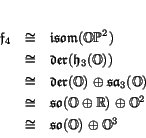4.2
The second smallest of the exceptional Lie groups is the 52-dimensional
group ![]() . The geometric meaning of this group became clear in a
number of nearly simultaneous papers by various mathematicians. In
1949, Jordan constructed the octonionic projective plane using
projections in
. The geometric meaning of this group became clear in a
number of nearly simultaneous papers by various mathematicians. In
1949, Jordan constructed the octonionic projective plane using
projections in ![]() . One year later, Armand Borel [8]
noted that
. One year later, Armand Borel [8]
noted that ![]() is the isometry group of a 16-dimensional projective
plane. In fact, this plane is none other than than
is the isometry group of a 16-dimensional projective
plane. In fact, this plane is none other than than ![]() . Also
in 1950, Claude Chevalley and Richard Schafer [18] showed that
. Also
in 1950, Claude Chevalley and Richard Schafer [18] showed that
![]() is the automorphism group of
is the automorphism group of ![]() . In 1951, Freudenthal
[35] embarked upon a long series of papers in which he
described not only
. In 1951, Freudenthal
[35] embarked upon a long series of papers in which he
described not only ![]() but also the other exceptional Lie groups
using octonionic projective geometry. To survey these developments, one
still cannot do better than to read his classic 1964 paper on Lie groups
and the foundations of geometry [38].
but also the other exceptional Lie groups
using octonionic projective geometry. To survey these developments, one
still cannot do better than to read his classic 1964 paper on Lie groups
and the foundations of geometry [38].
Let us take Chevalley and Schafer's result as the definition of ![]() :
:
In Section 3.4 we saw that the exceptional Jordan algebra can
be built using natural operations on the scalar, vector and spinor
representations of ![]() . This implies that
. This implies that ![]() is a
subgroup of
is a
subgroup of ![]() . Equation (3.4) makes it clear that
. Equation (3.4) makes it clear that
![]() is precisely the subgroup fixing the element
is precisely the subgroup fixing the element

This fact has various nice spinoffs. First, it gives an easy way to
compute the dimension of ![]() :
:
Equation (4.2) also implies that the tangent space of our
chosen point in ![]() is isomorphic to
is isomorphic to ![]() . But we already
know that this tangent space is just
. But we already
know that this tangent space is just ![]() , or in other words, the
spinor representation of
, or in other words, the
spinor representation of ![]() . We thus have
. We thus have
This last formula suggests that we decompose ![]() further using the
splitting of
further using the
splitting of ![]() into
into ![]() and
and ![]() .
It is easily seen by looking at matrices that for all
.
It is easily seen by looking at matrices that for all ![]() we have
we have
While elegant, none of these descriptions of ![]() gives a convenient
picture of all the derivations of the exceptional Jordan algebra. In
fact, there is a nice picture of this sort for
gives a convenient
picture of all the derivations of the exceptional Jordan algebra. In
fact, there is a nice picture of this sort for ![]() whenever
whenever ![]() is a normed division algebra. One way to get a derivation of the
Jordan algebra
is a normed division algebra. One way to get a derivation of the
Jordan algebra ![]() is to take a derivation of
is to take a derivation of ![]() and let it
act on each entry of the matrices in
and let it
act on each entry of the matrices in ![]() . Another way uses
elements of
. Another way uses
elements of
In equation (4.2), the subspace ![]() is always a Lie
subalgebra, but
is always a Lie
subalgebra, but ![]() is not unless
is not unless ![]() is commutative and
associative — in which case
is commutative and
associative — in which case ![]() vanishes. Nonetheless, there
is a formula for the brackets in
vanishes. Nonetheless, there
is a formula for the brackets in
![]() which applies in every
case [70]. Given
which applies in every
case [70]. Given
![]() and
and
![]() , we
have
, we
have
Summarizing these different descriptions of ![]() , we have:
, we have:
Theorem 5.
The compact real form of
![]() is given by
is given by

© 2001 John Baez